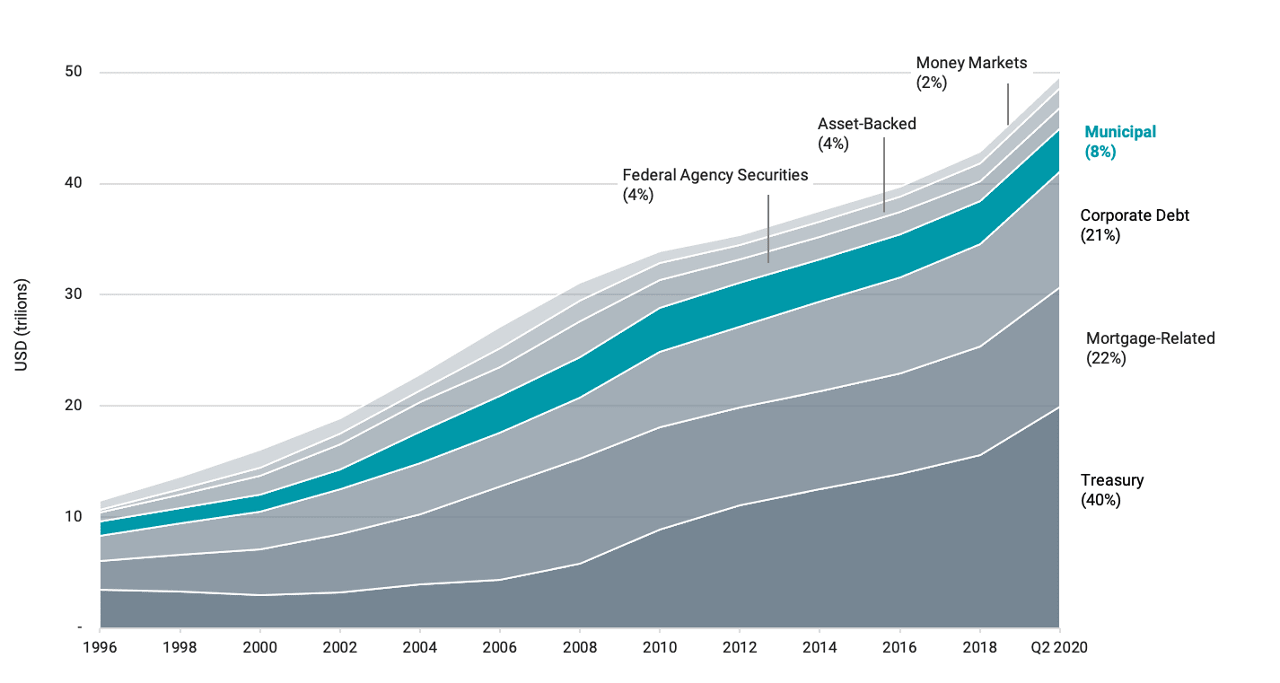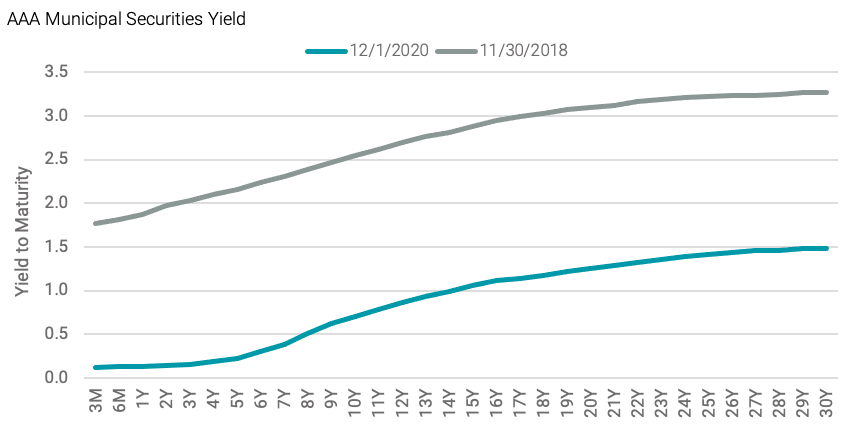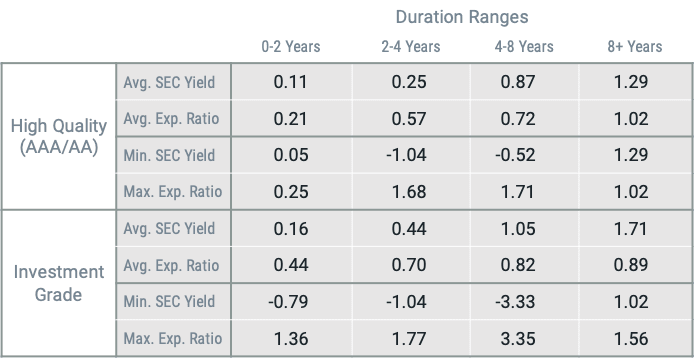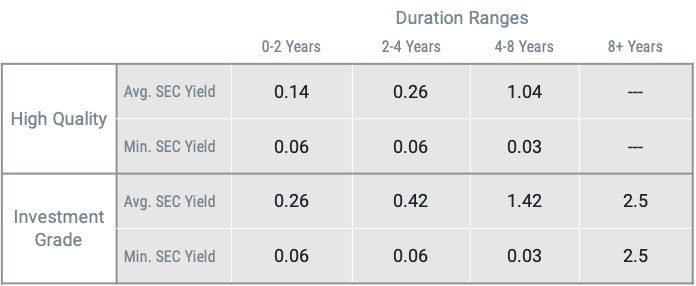When Do Municipal Bonds Make Sense in a Fixed-Income Allocation?
Key Takeaways
The appropriate mix of taxable and municipal bonds depends on a variety of factors specific to each client’s goals and circumstances.
Investors should consider the level of interest rates and corresponding expected absolute tax savings when evaluating this tradeoff.
At today’s yields, the tax savings from short-term, high-quality municipal bonds may not warrant the concentration risk.
Just as investors can only “eat” net returns, not gross returns, in taxable accounts they can only eat after-tax returns. For many investors, income tax rates are also higher than capital gains tax rates. Longer horizons magnify this difference because income is distributed each year, while capital gains can be deferred until realization. Although differences in vehicle structures can have a meaningful impact on the tax efficiency of an investment, the characteristics of the investment strategy and the underlying securities also matter. The latter is particularly true in fixed income.
Municipal bonds (munis) have provided a great way to potentially reduce the “tax drag” in fixed-income investments. In most cases, income from munis is exempt from federal and, in some cases, state income taxes. There were a little less than $4 trillion worth of municipal issues outstanding, which represents about 7.5% of the U.S. investment-grade fixed-income universe, as of the end of Q2 2020. This is illustrated in Figure 1, along with a look back at how the investment-grade universe has evolved over the last 25 years. While the amount of municipal debt outstanding is similar to 10 years ago (just a little under $4 trillion as of the end of 2010), at that time muni bonds represented 11.7% of the universe.
Figure 1 | The Investment-Grade Debt Universe Through Time

Data as of June 30, 2020. Source: Fixed Income Outstanding Chart, Securities Industry and Financial Markets Association. Issuance is long-term instruments only. Asset-backed securities (ABS) and mortgage-backed securities (MBS) outstanding data lags by one quarter.
Muni bonds tend to serve a specific clientele. Many investors in high income tax brackets are willing to sacrifice some diversification and concentrate their portfolios in munis based on the potential return benefit they provide in their income yield due to the tax exemptions we discussed above. Most people evaluate this tradeoff by looking at tax-equivalent yields considering the investor’s marginal tax rate.
For example, if a municipal bond is yielding 2%, and the investor’s marginal tax rate is 39%, the taxable equivalent yield would be 3.27%. Obviously, changes in interest rates impact this equation. Figure 2 illustrates how the yield on five-year AAA-rated munis has changed over the last 10+ years.
Figure 2 | High-Quality Municipal Yields Have Declined

Data from 1/30/2009 – 12/1/2020. Source: Bloomberg.
The corresponding tax savings investing in municipal securities provides has changed dramatically over the years depending on the level of interest rates. In Figure 3, we compare today’s AAA-rated muni yield curve to two years ago. We can see that interest rates in munis (and corresponding tax savings) were much higher than today.
Figure 3 | Interest Rate Levels Affect Tax Savings

Data from 11/30/2018 – 12/1/2020. Source: Bloomberg Muni AAA Yield Curve.
Curtailing the Tax Drag on Performance
Proportionally, the savings are similar today as in previous years when interest rates were higher, but we believe investors should look beyond that and consider the objective of the municipal allocation—seeking to reduce or minimize the tax drag on performance. The intuition is obvious. If interest rates are zero, there are no tax savings despite the difference in tax rates.
So, at very low interest rates, there are savings, but they are very small. At today’s interest rate levels—for short-term, high-quality securities, in particular—investing in short-term munis provides potential expected tax savings that are extremely low. This means the benefits associated with a significant overweight to this part of the fixed-income universe may not be worth the reduction in diversification and after-tax yields available in other parts of investment-grade debt.
We can use a current example to quantify the tradeoff. You can see in Figure 3 that as of November 20, AAA-rated munis with one year to maturity were yielding about 14 basis points (bps), which is in line with current yields of U.S. Treasuries with one year to maturity. The expected tax savings is 5.5 bps, but one investment is exposed to the credit risk of Treasuries, and the other munis.
This evaluation can be complicated by the fact that investors are often choosing between different commingled investment vehicles, like mutual funds or exchange-traded funds (ETFs), to fill an allocation in their portfolios. Fortunately, the Securities and Exchange Commission (SEC) mandates the calculation of a specific yield by these funds (30-Day SEC Yield) to allow investors to understand what income has been generated over the last month (after expenses) and how that would translate into an annual yield if the fund generated that amount for each month. Investors shouldn’t view this characteristic in isolation, but alongside other information, like duration and credit quality, it can help them get a better sense of the tradeoffs for various investments.
Figure 4 includes data on yields and expense ratios for mutual funds and ETFs investing in municipal securities, separated into categories by duration and credit quality. Two obvious observations are that higher average expense ratios and shorter duration generally mean lower yields.
Figure 4 | What Do SEC Yields Look Like Across Municipal Bond Funds?

Data as of 11/20/2020. Source: Morningstar; excludes funds/ETFs without data and fund of funds.
If we zero in on the high-quality, shortest duration bucket in this example, we see the SEC yield is on average only 0.11%, but it can be as low as 0.05%. At that yield, depending on your tax bracket and state of residence, the savings could be as little as single-digit basis points, but the risk exposure to this single sector is still the same as when interest rates were higher.
Because funds with high expense ratios can impact the average SEC yield for each category, in Figure 5 we show the same information, but constrain the universe to funds and ETFs with expense ratios less than 0.20%. Here, we can more clearly see the relationship between duration and average yields. While the average yield for the high-quality, shortest duration bucket increases to 0.14%, it is still meaningfully lower than the other buckets.
As our previous example shows, the tax benefit of having short-term, high-quality munis dominate your allocation versus a more diversified basket of securities from different fixed-income sectors may not provide sufficient compensation for the concentration risk. For longer durations and broader – but still investment grade – credit qualities, yields for munis (and expected tax savings) are higher, making the tradeoff between taxable versus muni-focused bond allocations potentially more appealing.
Determining the appropriate mix of taxable and municipal bonds in a fixed-income allocation depends on a variety of factors specific to each client and their goals. Tax efficiency should absolutely be front of mind when constructing allocations. But when you evaluate these tradeoffs, also consider the level of interest rates and corresponding expected absolute tax savings. At today’s yields, the tax savings from short-term, high-quality municipal bonds may not warrant the concentration risk.
Figure 5 | Enough Bang for Your Buck? Average SEC Yields for Low-Cost Municipal Bond Funds

Data as of 11/20/2020. Source: Morningstar; excludes funds/ETFs without data and fund of funds. Funds included have expense ratios less than 0.20%.
Investment return and principal value of security investments will fluctuate. The value at the time of redemption may be more or less than the original cost. Past performance is no guarantee of future results.
Diversification does not assure a profit, nor does it protect against loss of principal.
This material has been prepared for educational purposes only. It is not intended to provide, and should not be relied upon for, investment, accounting, legal or tax advice.
The opinions expressed are those of the investment portfolio team and are no guarantee of the future performance of any Avantis Investors portfolio. This information is not intended as a personalized recommendation or fiduciary advice and should not be relied upon for investment, accounting, legal or tax advice. References to specific securities are for illustrative purposes only and are not intended as recommendations to purchase or sell securities.
IRS Circular 230 Disclosure: American Century Companies, Inc. and its affiliates do not provide tax advice. Accordingly, any discussion of U.S. tax matters contained herein (including any attachments) is not intended or written to be used, and cannot be used in connection with the promotion, marketing or recommendation by anyone unaffiliated with American Century Companies, Inc. of any of the matters addressed herein or for the purpose of avoiding U.S. tax-related penalties.
FOR FINANCIAL PROFESSIONAL USE ONLY/ NOT FOR DISTRIBUTION TO THE PUBLIC
